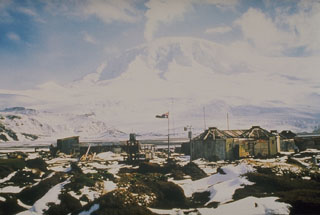Report on Heard (Australia) — October 2019
Bulletin of the Global Volcanism Network, vol. 44, no. 10 (October 2019)
Managing Editor: Edward Venzke.
Research and preparation by Paul Berger.
Heard (Australia) Ongoing thermal anomalies at the summit crater during April-September 2019
Please cite this report as:
Global Volcanism Program, 2019. Report on Heard (Australia) (Venzke, E., ed.). Bulletin of the Global Volcanism Network, 44:10. Smithsonian Institution. https://doi.org/10.5479/si.GVP.BGVN201910-234010
Heard
Australia
53.106°S, 73.513°E; summit elev. 2745 m
All times are local (unless otherwise noted)
Heard Island, in the Southern Indian Ocean, is about 4,000 km from its closest point to Australia and about 1,500 km from the closest point in Antarctica. Because of the island's remoteness, monitoring is primarily accomplished by satellites. The Big Ben volcano has been active intermittently since 1910, if not before (BGVN 42:10), and thermal anomalies have been observed every month since June 2018 (BGVN 43:10, 44:04). The current reporting period is from April to September 2019.
During April-September 2019, only one thermal anomaly was detected with the MODIS satellite instruments analyzed using the MODVOLC algorithm, and that was on 10 June (2 pixels). The MIROVA (Middle InfraRed Observation of Volcanic Activity) volcano hotspot detection system, also based on analysis of MODIS data, detected a few scattered thermal alerts in late May-early June and three in September; most were between 1-2 km of the summit and of low to moderate power.
The island is usually covered by heavy clouds, obscuring satellite views. However, Sentinel-2 satellite imagery detected cloud-obscured thermal anomalies during the reporting period, most likely due to a persistent lava lake and possibly lava flows (BGVN 41:08).
Geological Summary. Heard Island on the Kerguelen Plateau in the southern Indian Ocean consists primarily of the emergent portion of two volcanic structures. The large glacier-covered composite basaltic-to-trachytic cone of Big Ben comprises most of the island, and the smaller Mt. Dixon lies at the NW tip of the island across a narrow isthmus. Little is known about the structure of Big Ben because of its extensive ice cover. The active Mawson Peak forms the island's high point and lies within a 5-6 km wide caldera breached to the SW side of Big Ben. Small satellitic scoria cones are mostly located on the northern coast. Several subglacial eruptions have been reported at this isolated volcano, but observations are infrequent and additional activity may have occurred.
Information Contacts: Sentinel Hub Playground (URL: https://www.sentinel-hub.com/explore/sentinel-playground); Hawai'i Institute of Geophysics and Planetology (HIGP) - MODVOLC Thermal Alerts System, School of Ocean and Earth Science and Technology (SOEST), Univ. of Hawai'i, 2525 Correa Road, Honolulu, HI 96822, USA (URL: http://modis.higp.hawaii.edu/); MIROVA (Middle InfraRed Observation of Volcanic Activity), a collaborative project between the Universities of Turin and Florence (Italy) supported by the Centre for Volcanic Risk of the Italian Civil Protection Department (URL: http://www.mirovaweb.it/).

